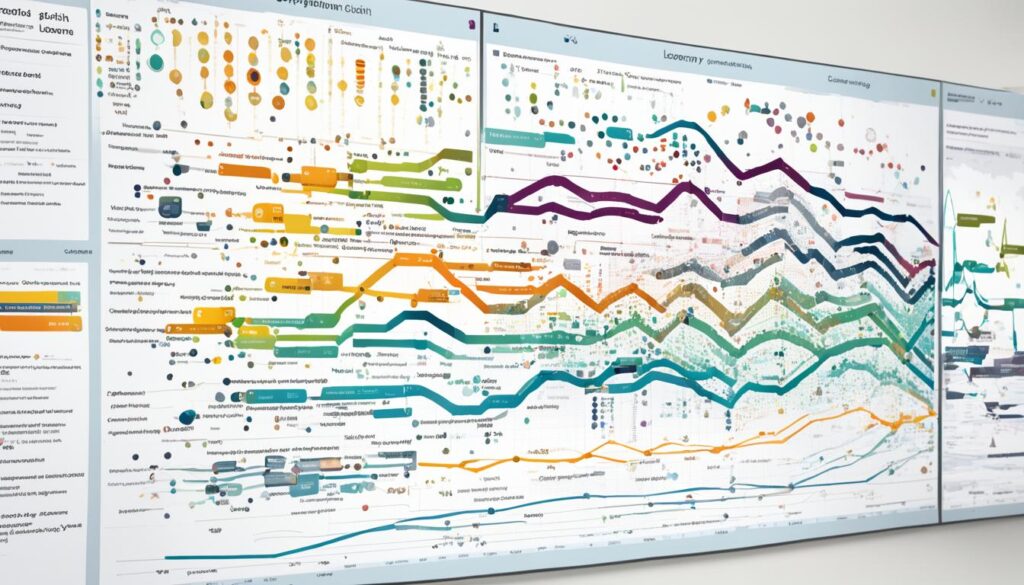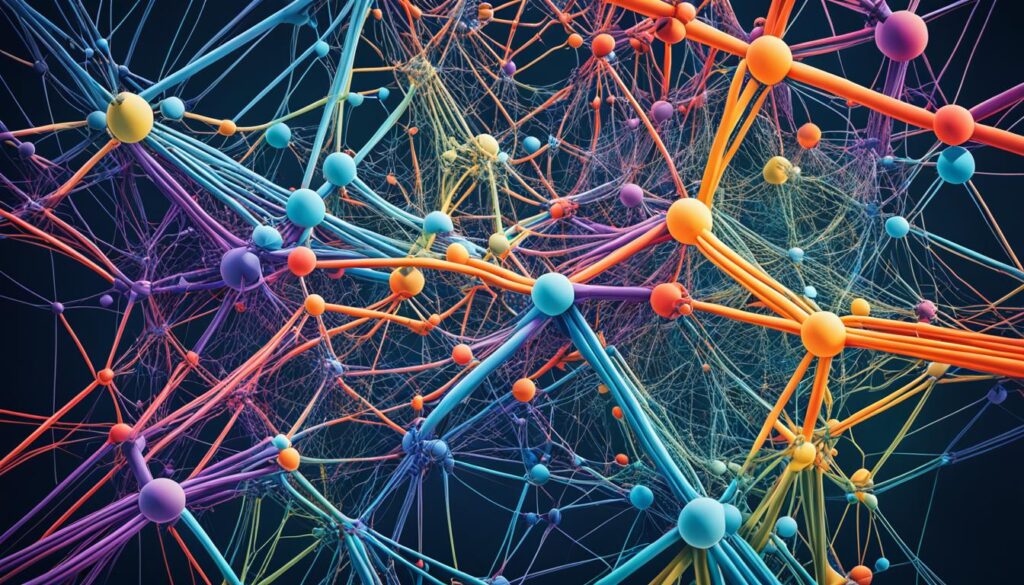Have you ever thought about how learning Python M could change our tech and analytics? In today’s fast world, Python machine learning and data analysis are key. They help us solve complex problems in many areas.
Python M is versatile and offers great chances for data scientists and fans. Let’s dive into its world together. We’ll see how it changes tech solutions.
Understanding Python M and Its Applications
Python M is a key tool in today’s tech world, especially for machine learning. It offers many functionalities and libraries for making complex machine learning apps. These tools help us create systems that can predict outcomes, make decisions automatically, and process data in real-time.
The applications of Python M are wide-ranging across different sectors. For instance, in healthcare, it helps analyze patient data to predict outcomes and improve treatment plans. In finance, it powers algorithms for better investment decisions by understanding market trends. E-commerce uses Python M for personalized product suggestions and analyzing customer behavior.
Frameworks like TensorFlow and Scikit-learn play a big role in making smart apps. They let us use complex algorithms efficiently. Python M makes it easier to add machine learning models to various industries, meeting their changing needs.
| Industry | Application | Benefits |
|---|---|---|
| Healthcare | Predictive Health Analytics | Improved patient outcomes, better resource allocation |
| Finance | Algorithmic Trading | Enhanced decision-making, reduced risks |
| E-commerce | Recommendation Systems | Increased sales, personalized shopping experience |
By exploring Python M’s uses, we can use its power for new solutions in many areas. This helps us make better decisions based on data.
Getting Started with Python M

Starting with Python M is thrilling. First, we need to set up Python and libraries like NumPy, Pandas, and scikit-learn. Download the newest Python from the official site. Make sure to add Python to your system path during installation.
Then, we must create a good python environment. Virtual environments are great for managing project dependencies. Use the command:
python -m venv myenvOnce the virtual environment is made, activate it. For Windows, use:
myenv\Scripts\activateFor Mac or Linux, use:
source myenv/bin/activateCreating a coding environment is key for our projects. Tools like Jupyter Notebook or Google Colab are great for coding in Python M. Install Jupyter with:
pip install jupyterExploring these tools makes coding easier and learning more fun. The early steps of starting with Python M might seem tough, but with the right help and tools, we’ll get the hang of it quickly.
Key Features of Python for Machine Learning
Python is a top choice for machine learning because it’s easy to use and has powerful tools. It’s great for both new and experienced users. Python M comes with libraries like NumPy, Pandas, and Matplotlib. These tools are key for working with data and making it easier to analyze.
Python’s code is simple and easy to read, which helps teams work faster. This lets us quickly test and improve our models. In a field where being quick to adapt is key, this is a big plus.
Python is also very flexible, letting us use different programming styles. This is useful for a wide range of projects, from simple scripts to complex apps. Working together is easy thanks to Python’s clear structure and strong community support.
Here are some top features of Python for machine learning:
- Library Ecosystem: A wide array of libraries facilitating statistical analysis and visualization.
- Simplicity and Readability: Code that is easy to read and write, promoting better collaboration.
- Community Support: A robust community that contributes to continuous improvement and innovation.
- Flexibility: The ability to utilize multiple programming paradigms that cater to diverse project requirements.
Below is a table showing some of the main libraries and tools for machine learning in Python:
| Library | Primary Function | Best Use Cases |
|---|---|---|
| NumPy | Numerical Computing | Data analysis, matrix operations |
| Pandas | Data Manipulation | Data cleaning, exploration |
| Matplotlib | Data Visualization | Graphing, plotting data points |
| Scikit-learn | Machine Learning Algorithms | Classification, regression, clustering |
| TensorFlow | Deep Learning | Neural networks, complex models |
Python M for Data Analysis

Python is a top choice for handling big data, thanks to its many tools. We look at python data analysis and the best libraries for data analysis. These tools help us work with data better.
Popular Libraries for Data Analysis
Choosing the right python data analysis libraries is key. Here are some top ones:
- Pandas: Key for working with structured data, it makes data easy to handle.
- NumPy: Great for numbers, it supports big arrays and matrices.
- Matplotlib: A main tool for making graphs, from simple to interactive ones.
- Seaborn: Uses Matplotlib to make stats easier to see with nice designs.
Data Visualization Techniques
Seeing data in a clear way is vital for understanding our findings. We use different methods to share our insights. These include:
- Line Graphs: Good for showing changes over time.
- Bar Charts: Great for comparing different groups.
- Scatter Plots: Perfect for showing how variables relate.
- Heat Maps: Useful for seeing data density in two dimensions.
Using these data visualization tools helps us make our findings clear. This makes our work more useful for making decisions.
Python M: Harnessing the Power of Python for Natural Language Processing
In our digital age, the role of python natural language processing is clear. NLP with Python helps us tackle complex tasks like understanding human language. This changes how we use technology. Python’s tools make text analysis easy, letting us build apps that get human communication.
Tasks like speech recognition, sentiment analysis, and text summarization are key in nlp with python. These tasks show how Python can handle language data. For example, speech recognition turns spoken words into text, making it easier for humans and machines to talk.
Sentiment analysis shows what people think by looking at digital talks. Text analysis in this area helps us understand social media, customer reviews, and more. This helps businesses know what customers feel and adjust their plans.
Several strong libraries support these NLP tasks. Two top ones are:
- NLTK (Natural Language Toolkit): Great for beginners, it handles tasks like breaking down text and reducing words to their base form.
- SpaCy: Built for big projects, SpaCy is fast and efficient, perfect for finding specific words and understanding sentence structure.
Using these tools, we can improve our python natural language processing skills. Analyzing and understanding language is key to making advanced apps. This makes user interactions better and gives insights in many fields.
| Library | Features | Best For |
|---|---|---|
| NLTK | Comprehensive tools for tokenization, stemming, and linguistic processing | Beginners and educational purposes |
| SpaCy | Fast processing, named entity recognition, part-of-speech tagging | Production and scalable applications |
Exploring Python Scikit-learn for Machine Learning

The python scikit-learn library is a key tool for making machine learning models. It’s known for being efficient and easy to use. This makes it a favorite among data scientists. We’ll look at what it offers and why it’s good for our projects.
Core Functionality and Advantages
Scikit-learn supports many algorithms for classification and regression. It has important features like:
- Standardized APIs for different algorithms, making it easy to switch between models.
- Tools for cleaning and preparing data before we start.
- Methods for picking and checking our models, helping us fine-tune them.
These tools make us more efficient and help our models be more accurate and reliable.
Implementing Classification and Regression Models
With the python scikit-learn library, we can quickly set up classification and regression models. Here’s a simple guide:
- First, import the libraries we need, like scikit-learn, pandas, and NumPy.
- Next, prepare the data by splitting it into training and testing parts.
- Then, pick a model, like Decision Trees for classifying or Linear Regression for predicting.
- Train the model on the data, then use it to make predictions on the test set.
- Finally, check how well the model did using metrics like accuracy or mean squared error.
By doing these steps, we can make and test machine learning models that fit our needs.
Diving into Python Deep Learning
We explore the world of python deep learning. Here, complex algorithms analyze data like humans do. It’s key to understand how deep learning works to see how systems think like us through neural networks and layers.
Overview of Deep Learning Principles
Deep learning models use neural networks with layers that work together. These models have a few main parts:
- Neural Networks: These have nodes (neurons) in layers like input, hidden, and output.
- Activation Functions: These decide what a neuron sends out, affecting how accurate the model is.
- Training: Models learn by going through data, adjusting their settings to get better at predicting.
Comparison of Frameworks: TensorFlow vs. Keras
Choosing the right deep learning framework is important. TensorFlow and Keras are top picks for developers. Here’s how they stack up:
| Feature | TensorFlow | Keras |
|---|---|---|
| Ease of Use | More complex, needing a deep understanding | Easy and straightforward, great for beginners |
| Flexibility | Very flexible for custom models | High-level APIs for quick testing |
| Performance | Works well on both CPU and GPU | Based on TensorFlow, performs well but less optimized |
| Community Support | Strong community with lots of resources | Growing community with many tutorials |
When picking between TensorFlow and Keras, think about your project needs, your skills, and what you want to achieve with python deep learning.
Advanced Machine Learning Techniques with Python M
Exploring advanced machine learning is key. We look at python m techniques that boost model performance. These include ensemble methods, hyperparameter tuning, and deep learning optimizations. They are vital for better model accuracy and strength.
Ensemble methods, like bagging and boosting, combine models for better performance. This way, we reduce errors and make forecasts more reliable. Hyperparameter tuning also helps by fine-tuning model settings for better generalization.
Model optimization is also crucial. Libraries like Scikit-learn and TensorFlow let us use advanced algorithms. Key strategies for optimization include:
- Grid Search: A brute-force approach for finding the best hyperparameter combination.
- Random Search: A more efficient alternative that samples a wide range of hyperparameters.
- Bayesian Optimization: This advanced method helps optimize hyperparameters by modeling their distributions.
Here’s a table that shows different optimization methods and their benefits:
| Method | Description | Advantages |
|---|---|---|
| Grid Search | Exhaustively searches through a specified hyperparameter space. | Simple to implement, covers all combinations. |
| Random Search | Samples randomly from the hyperparameter space. | More time-efficient, good for large spaces. |
| Bayesian Optimization | Models and optimizes hyperparameters based on past evaluations. | Often converges faster to optimal values. |
By using these advanced machine learning techniques, we can greatly improve our models. Staying updated with these methods keeps us leading in machine learning.
Utilizing Python TensorFlow for Neural Networks

Python TensorFlow is a top choice for building neural networks. It’s great at handling complex math needed for neural networks. With tensors, layers, and optimizers, we can make models that fit our tasks well.
Neural networks have layers like input, hidden, and output. Each layer has neurons that connect to each other. Python TensorFlow makes it easy to create these layers. This lets us make simple or complex neural networks.
When using neural networks with TensorFlow, we need to adjust settings. This means changing learning rates, batch sizes, and epochs to improve our model. Beginners can use built-in tools to help with this, focusing on the main tasks.
We’ll look at some big tensorflow applications. For instance, computer vision uses it for things like image classification and object detection. On the other hand, natural language processing tasks like sentiment analysis use recurrent neural networks.
As we keep exploring Python TensorFlow and neural networks, the possibilities grow. Using TensorFlow helps us make smarter systems. It also lets us innovate in many fields, showing how powerful neural networks with TensorFlow can be.
Hands-On with Python Keras for Model Development
In this section, we’ll dive into the practical side of using python keras for model development. Keras makes it easy to create and train models, focusing on real-world applications.
Creating and Training Models in Keras
First, we use Keras to build different model types. We define a model, compile it, and then train it. Here are the steps with code examples for clarity. Following best practices helps us train models more efficiently in keras.
# Importing Required Libraries from keras.models import Sequential from keras.layers import Dense # Defining the Model model = Sequential() model.add(Dense(64, activation='relu', input_dim=8)) model.add(Dense(1, activation='sigmoid')) # Compiling the Model model.compile(loss='binary_crossentropy', optimizer='adam', metrics=['accuracy']) # Training the Model model.fit(X_train, y_train, epochs=10, batch_size=10)
Training models in keras means picking the right parameters and knowing the data well. It’s key to check how the model does and tweak it as needed. We need a solid plan for training models, keeping our goals in mind.
Testing the model with unseen data is a key step. It confirms the model’s ability to work outside the training data. For tips on making the most of model development, check out more resources on effective configuration management.
By using these methods, we can make models that are both effective and adaptable in the python keras framework. Whether it’s for classification or regression, following best practices will boost our model’s performance and flexibility in a fast-changing tech world.
Building Robust NLP Applications with Python NLP Libraries
When we work on NLP applications, using python nlp libraries boosts our skills. These libraries offer many tools for handling text well. This lets us do complex tasks easily. We use libraries like NLTK, SpaCy, and Transformers for tasks from chatbots to advanced search.
These libraries help us solve NLP problems. NLTK gives us basic tools for breaking down text and understanding words. SpaCy is easier to use and helps with finding specific words and understanding sentence structure. Transformers let us use top models like BERT and GPT for understanding and creating text.
Let’s look at a few examples of how we use these libraries:
- Automated Chatbots: We make chatbots that give quick customer help by using NLTK to understand and answer questions.
- Document Classification: With SpaCy, we can automatically sort documents by their content, making work easier for businesses.
- Semantic Search: Transformers help us make search better in apps, so users can find what they need more easily.
Adding these python nlp libraries to our projects makes them work better and gives users a smooth experience. Each library has its own strengths and best uses. This makes our projects flexible and ready for new ideas in NLP.
| Library | Main Features | Use Cases |
|---|---|---|
| NLTK | Tokenization, Stemming, POS Tagging | Chatbots, Text Mining |
| SpaCy | NER, Dependency Parsing, Speed | Document Classification, Named Entity Recognition |
| Transformers | Pre-trained Models, Fine-tuning | Text Generation, Semantic Search |
Community Resources and Support for Python M
Getting involved with the python community resources is key for deepening your Python M knowledge. Many platforms offer great support through forums, tutorials, and projects. GitHub is a place where developers can work on open-source projects, giving learners real-world experience.
Online courses are a great way to learn Python M. Sites like Coursera and Udacity have courses for all skill levels. You can talk with instructors and other learners, making learning more interactive.
Forums like Stack Overflow and Reddit’s r/learnpython are lively spots for asking questions and sharing tips. They help with sharing knowledge and getting different views on programming challenges.
Don’t forget to check out blogs and podcasts about Python M. They give fresh insights and keep you up-to-date with new trends. For those interested in how these techs are used in the industry, our future trends section is full of inspiration and advice.
Using these python community resources and platforms can really boost our skills and grasp of Python M. The online support means you’re never alone in your learning journey.
Common Challenges and Best Practices in Python M Development
In our journey through Python M development, we face many challenges in Python M. Debugging model performance is one big challenge. It’s like finding a needle in a haystack to see why a model doesn’t perform well. Handling large datasets is also tough, especially when we want to work fast and efficiently.
Using best practices for Python helps a lot. Keeping our code clean and organized makes it easier to debug. Writing good documentation helps both current and future developers understand complex parts of the code.
Creating a strong testing framework is key in python development. Unit tests and integration tests help find problems early. This saves time and money later. Here’s a roadmap with common challenges and strategies for best practices.
| Common Challenges | Best Practices |
|---|---|
| Debugging model performance issues | Implement systematic logging to track performance metrics. |
| Managing large datasets | Utilize data management libraries like Pandas effectively. |
| Inconsistent coding styles | Adhere to PEP 8 standards for cleaner code. |
| Scalability of models | Design models with future expansions in mind. |
| Poor documentation | Maintain updated documentation for ease of understanding. |
Future Trends in Python and Machine Learning
Technology is always changing, and we see new trends in Python and machine learning. Emerging technologies will change how we make and use machine learning solutions. Automation is getting better, making data handling more efficient and accurate.
AI ethics is becoming more important. It’s about being accountable, transparent, and fair. These values are key for machine learning to grow in a good way. Everyone needs to focus on these to build trust in AI.
Python is teaming up with quantum computing. This is a big deal because it means we can solve complex problems faster. It’s going to change how we tackle tough challenges in machine learning.
We’ll also see new, advanced frameworks for Python and machine learning. These will meet the needs of businesses and keep developers ahead in their careers.
| Trend | Description |
|---|---|
| Automation Advancements | Increased efficiency and accuracy in data handling through automated processes. |
| AI Ethics | Focusing on accountability and transparency to build trust in AI systems. |
| Quantum Computing Integration | Leveraging quantum technologies to enhance processing power and capabilities. |
| Emerging Frameworks | Development of new frameworks tailored for dynamic business needs in the industry. |
Conclusion
As we wrap up our look at Python M, it’s clear this tool is a big deal for data analysis, machine learning, and natural language processing. Python’s flexibility and wide use help us handle tough tasks and make our work easier. This shows why learning Python M is key for those wanting to succeed in today’s tech world.
We’ve looked at the big features and libraries that make Python M so useful for professionals. Using these tools helps us improve our projects, skills, and methods across different areas. Staying up to date with this tech helps us keep moving forward in our careers and adapt to new trends.
In closing, we urge our readers to connect with the Python community. Sharing what we know and learn helps us grow and use Python M’s full potential. This call to action encourages us to keep learning and getting ready for the future of machine learning and more.



Leave a Reply